|
|
|
Helping Your Child Learn Math - June
1999
Activities
Math for the Fun of It

During summer vacations, on rainy days, while waiting
at the doctor's office, or on a stroll through the neighborhoodlearning
never ends. Your children can explore some fascinating mathematical possibilities
in the world around them every day. For instance, math can be found outdoors
in nature: look for symmetry in leaves; count the number, sizes, and kinds
of trees on your street; and look at the various shapes and patterns of
blooming flowers. Children will be learning math and enjoying it
too! The activities in this section can be done anytime and anywhere.
Guess If You Can
Grades K-5
What to do
- Let your child think of a number between a stated range of numbers
while you try to guess the number by asking questions. Here is a sample
conversation.
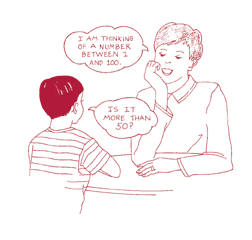 Child:
I am thinking of a number between 1 and 100. Child:
I am thinking of a number between 1 and 100.
Parent: Is it more than 50?
Child: No.
Parent: Is it an even number?
Child: No.
Parent: Is it more than 20 but less than 40?
Child: Yes.
Parent: Can you reach it by starting at zero and counting by
3's?
Child: Yes.
(At this stage, your child could be thinking of 21, 27, 33, or 39.)
- Figure out the answers to your own questions.
- After you have guessed your child's number, let your child guess
a number from you by asking similar questions.
| Parent Pointer |
 |
It is important to help children develop an understanding
of the characteristics and meanings of numbers. |

What Are the Coins?
Grades 2-5
What you'll need
Some coins
What to do
Ask your child the following questions:
- I have three coins in my pocket. They are worth 7 cents. What do
I have? (a nickel and 2 pennies)
- I have three coins in my pocket. They are worth 16 cents. What do
I have? (a dime, a nickel, a penny)
- I have three coins in my pocket. They are worth 11 cents. What do
I have? (2 nickels and 1 penny)
- I have three coins in my pockets. They are worth 30 cents. What do
I have? (3 dimes)
- I have six coins in my pocket. They are worth 30 cents. What could
I have? (1 quarter and 5 pennies or 6 nickels). This problem has more
than one answer. It is challenging for children to experience problems
like this.
- I have coins in my pocket, which have a value of 11 cents. How many
coins could I have?
You get the idea! Give your child a few coins to figure
out the answers.
| Parent Pointer |
 |
Use this activity to help your child develop an
understanding of patterns and variables (the unknown) to solve a
problem. This is critical to understanding algebra.
|
What Are My Chances?
Grades K-5
What you'll need
Two coins, paper, and pencil to keep score
What to do
Play these games with your child:
- Flip one coin. Every time it comes up heads, your child gets 1 point.
Every time it comes up tails, you get 1 point. Flip it 50 times. Tally
by 5's to make it easier to keep track of scores. The person with the
most points wins. If one person has 10 points more than the other person
does, score an extra 10 points. Does this happen very often? Why not?
- Flip two
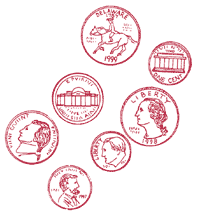 coins. If the coins come up two tails or two heads, your child scores
1 point. If it comes up heads and tails, you get 1 point. After 50 flips,
see who has more points. Do you think the game is fair? What if one
person received 2 points for every double heads and the other person
received 1 point for everything else. Is this fair?
coins. If the coins come up two tails or two heads, your child scores
1 point. If it comes up heads and tails, you get 1 point. After 50 flips,
see who has more points. Do you think the game is fair? What if one
person received 2 points for every double heads and the other person
received 1 point for everything else. Is this fair?
- Flip one coin. Then flip the other. If the second coin matches the
first coin, your child scores 1 point. If the second coin doesn't match
the first coin, you receive 1 point. Try this 50 times. Is the result
the same as in the previous game?
| Parent Pointer |
 |
Understanding probability is essential in many areas
of mathematics. Playing games that involve chance is one way to explore
the laws of probability. |
Money Match
 Grades
K-2 Grades
K-2
What you'll need
One number cube to roll; 10 of each coin (penny, nickel, dime, and quarter)
What to do
- For young players (5 and 6 year olds) use only two different coins
(pennies and nickels or nickels and dimes only). Older children can
use all types of coins.
- Explain that the object of the game is to be the first player to
earn a set amount (10 or 20 cents is a good amount).
 The first player rolls the number cube and gets the number of pennies
shown on the cube. Keep all like coins in batches or stacks of 5 or
10.
The first player rolls the number cube and gets the number of pennies
shown on the cube. Keep all like coins in batches or stacks of 5 or
10.
- As each player accumulates 5 pennies or more, the 5 pennies are traded
for a nickel. Players take turns rolling the cube to collect additional
coins.
- The first player to reach the set amount wins.
- Add the quarter to the game when the children are ready. As each
player accumulates 5 nickels, they are traded for quarters.
| Parent Pointer |
 |
Counting money and batching in groups of 2's, 5's,
or 10's teaches children matching skills and helps in the beginning
stages of addition and multiplication. Children also learn how to
identify coins and understand their values. |
More or Less
Grades K-2
What you'll need 
One coin, number cards (from book cover), scratch paper, pen, and pencil
What to do
Two players will play a card game where each will draw a card. The players
will compare cards to see who wins that round. Before you begin, flip
the coin and call "heads" or "tails" to see if the
winner of each round will be the person with a greater value card (heads)
or a smaller value card (tails).
- To begin the game, divide the cards evenly between the two players.
- Place the cards face down. Each player turns over one card at a time
and compares: Is mine more or less? How many more? How many less? The
player with the greater or smaller value card (depending on whether
heads or tails was tossed) takes both cards.
- The winner of the game is the player with more cards when all the
cards are gone from the stack.
- Now try the same activity with each player pulling two cards and
adding them. Which sum is more? How much more? How much less?
| Parent Pointer |
 |
Playing with numeral cards helps children learn to
compare quantities of numbers. Children can also learn addition and
subtraction. |
 Problem Solvers
Problem Solvers
Grades 1-3
What you'll need
Enough sets of cards so that each player has a set of cards numbered 1
through 6.
What to do
- Super sums. Each player writes numbers 1-12 on a piece of
paper. The object of the game is to be the first one to cross off all
the numbers on this list. Use only the cards 1-6. Each player picks
two cards and adds up the numbers on them. The players can choose to
mark off the numbers on the list by using the total value or crossing
off two or three numbers that make that value. For example, if a player
picks a 5 and a 6, the player can choose to cross out 11, or 5 and 6,
or 7 and 4, or 8 and 3, or 9 and 2, or 10 and 1, or 1, 2, and 8. If
a player cannot cross off a number, the player loses the turn. The first
player to cross off all the numbers wins.
- Make the sum of 100.Use only cards 1-6. Each player takes
turns drawing a card and each player must take 6 cards from the deck.
With each draw, a player decides whether to use the number on the card
in the 10s place or the 1s place so that the numbers total as close
to 100 as possible without going over. For example, suppose a player
draws the following cards in this order: 1, 6, 3, 2, 3, 2, and chooses
to use the numerals in the following way:
| Parent Pointer |
 |
This card game helps children develop various ways
to use numbers in different combinations and to see the many possibilities
of arriving at the same sum by adding different sets of numbers.
|
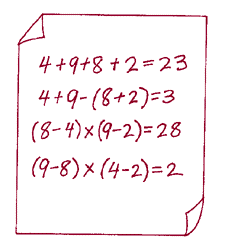 Card
Smarts Card
Smarts
Grades 3-5
What you'll need
Number cards, pencil, and paper
What to do
- How many numbers can we make? Give each player a piece of
paper and a pencil. Using the cards from 1 to 9, deal four cards out
with the numbers showing. Using all four cards and a choice of any combination
of addition, subtraction, multiplication, and division, have each player
see how many different numbers a person can get in 5 minutes. Players
get one point for each answer. For example, suppose the cards drawn
are 4, 8, 9, and 2. What numbers can be made?
- Make the most of it. This game is played with cards
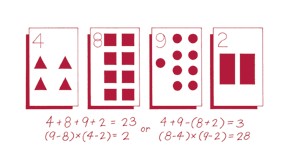 from
1 to 9. Each player alternates drawing one card at a time, trying to
create the largest 5-digit number possible. As the cards are drawn,
each player puts the cards down in their "place" (ten thousands,
thousands, hundreds, tens, ones) with the numbers showing. Once
placed, a card cannot be moved. The first player with the largest 5-digit
number wins. For example, if a 2 was drawn first, the player might place
it in the ones' place, but if the number had been an 8, it might have
been put in the ten thousands' place. from
1 to 9. Each player alternates drawing one card at a time, trying to
create the largest 5-digit number possible. As the cards are drawn,
each player puts the cards down in their "place" (ten thousands,
thousands, hundreds, tens, ones) with the numbers showing. Once
placed, a card cannot be moved. The first player with the largest 5-digit
number wins. For example, if a 2 was drawn first, the player might place
it in the ones' place, but if the number had been an 8, it might have
been put in the ten thousands' place.
| Parent Pointer |
 |
This card game helps children develop strategies
for using numbers in different combinations using addition, subtraction,
multiplication, and division.
|
Let's Play Store
Grades K-5
What you'll need
Empty containers (cartons or boxes), old magazines, books, newspapers,
calculator, pencil or crayon, and paper
What to do
- Help your child collect empty containers so that you can play as
if you were shopping at the grocery store. Gather the items and put
them on a table.
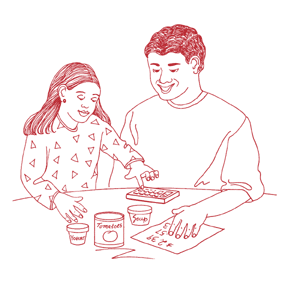
- Help your child think of a price for each item. Mark the prices on
the containers. You can even mark some items on sale.
- Pretend to be the customer while your child is the cashier.
- Teach your child the difference between the math symbols (+, -, ÷,
x, and =) and how they are used when using the calculator. Help your
child add the prices of each item on the calculator and total the amount
using the (=) symbol. Have your child write the total on a piece of
paper, which will be your receipt.
- While you and your child play store, you can ask questions likehow
much would it cost to buy three cartons of eggs? How much does 1 box
of soap cost, if they are 2 for $5.00? How much is my bill, if I don't
buy the cereal? How much more will it cost if I buy this magazine? Have
your child estimate the amounts of the items you are buying. Check to
see if the estimation is correct on the calculator.
| Parent Pointer |
 |
Learning to use the calculator will help your child
understand and apply estimation and reasoning skills, as well as learn
addition, subtraction, division, and multiplication. |

![[Table of Contents]](/parents/articles/pub_dom_images/up.gif)
 [What
Our Children Are Learning] [What
Our Children Are Learning]
|
|
|



